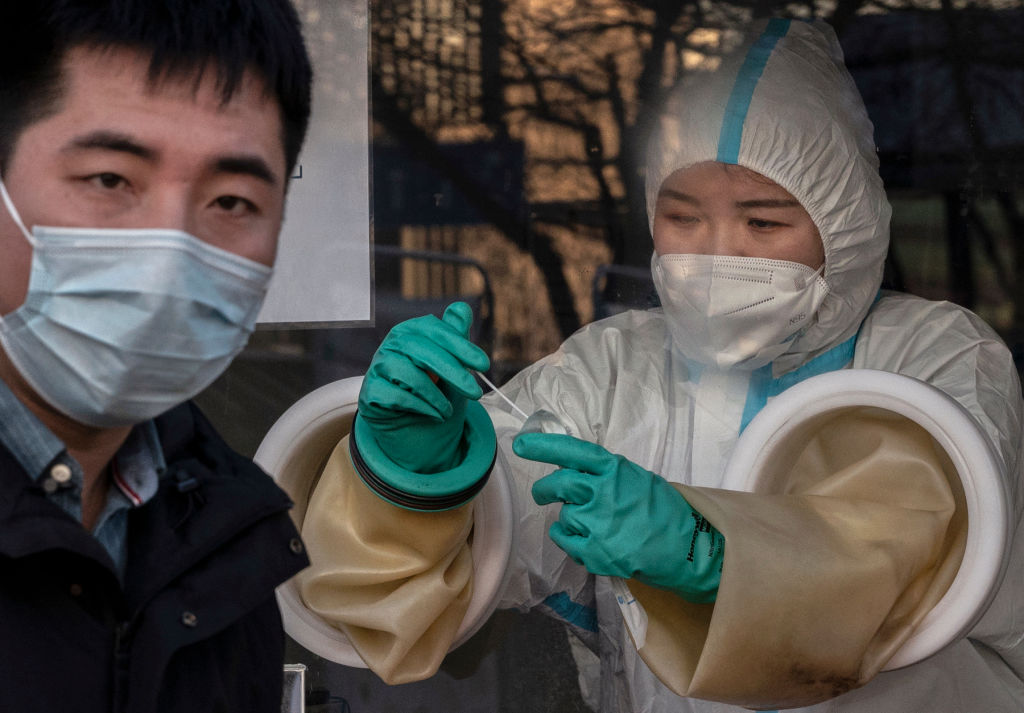The COVID-19 pandemic has entered its third year. More than 5.5 million lives have been lost around the world. Hospitals in many countries, including the U.S., are once again at crisis point, and coronavirus continues to jeopardize the global economy. And then there’s China. As one of the last countries to follow a zero-COVID policy, the world’s most populous nation has lost fewer than 6,000 of its 1.4 billion people to COVID-19, while expanding its economy by 8.1% in 2021 and registering a record trade surplus.
China has no shortage of critics, who decry its weeks-long city-wide lockdowns as sensational examples of authoritarian excess, and dismiss the zero-COVID approach as a looming failure, bad science or a ploy by the ruling Chinese Communist Party to shore up political control. But without whole-of-society support for the zero-COVID approach, it would be virtually impossible to make 20 million people stay at home over a handful of cases—as China has done in the run up to the Lunar New Year, mostly in the western city of Xi’an and in the northwestern province of Henan.
“Few countries have the ability like China in terms of effectively mobilizing the resources and capacities for pandemic control,” says Dr. Huang Yanzhong, a senior health policy expert from the Council of Foreign Relations (CFR)—not only in terms of “the clear commitment from the top leaders” but also “the overwhelming support from the public.”

The comparative fragility of China’s hospital system makes one important reason plain. According to OECD researchers, the U.S. had nearly 26 ICU beds per 100,000 people in 2018. Data from 2017 shows that Germany had nearly 34 per 100,000. By comparison, China in 2017 had fewer than 4 ICU beds for the same headcount. Following a Malthusian strategy of “letting COVID rip” through the country would lead to enormous loss of life.
Read More: Asia Has Kept COVID-19 at Bay for Two Years. Omicron Could Change That
The 2022 Beijing Winter Olympics in February, and the emergence of the highly contagious Omicron variant, will see China’s strategy put to a fresh test. The Chinese capital has reported its first local Omicron transmission, but is hoping to protect the Games with a “closed-loop bubble”—a system by which everybody participating in the Olympics will be physically isolated from the general population. If no major outbreak occurs, it will strengthen Beijing’s argument that its zero-COVID policy was the right approach all along. The strategy does not come cheap—according to the latest available figures, China spent nearly $63 billion in the first eleven months of 2020 to combat COVID-19—but the country appears willing to pay.
China’s zero-COVID approach saves lives
The term “zero-COVID” is a misnomer. “Currently, we are not capable of ensuring there will be no more new domestically transmitted infections,” the head of the National Health Commission’s COVID-19 task force, Liang Wannian, told the state-owned China Daily earlier this month. “But we are capable and confident of stamping out local infection clusters as quickly as possible.”
Sweeping inoculation, tracking and testing are the basis of this approach. According to Reuters, China has administered 2.93 billion does—enough to cover the entire population—and continues to administer more than 6 million does a day. It is notable that China continues to pursue its zero-COVID strategy despite such a high vaccination rate, even making allowances for what many believe to be the lower efficacy of Chinese-made inoculations. Perhaps it indicates an understanding that vaccines reduce the likelihood of severe illness but do not stop the spread of coronavirus.
Instead, there is enormous emphasis on community mitigation measures. Every citizen, foreign resident, and visitor to China is assigned a colored health code after completing a survey via a smartphone app. (Olympics attendees will require a separate app created for the Games.) Those with green status are allowed to move around, enter public facilities and board public transport. Those with red status (meaning that they either have COVID-19 or likely have COVID-19) or yellow status (meaning the holder is a close contact of someone with COVID-19) must be isolated until they recover, or complete quarantine, and acquire green status again.
Read More: We Must Learn From the Failed Global Response to COVID-19
Testing is intensive. According to figures cited in the South China Morning Post, more than 8,430 medical institutes in the country can conduct nucleic acid tests on a combined total of 12.55 million samples a day. When a case is found, city-wide and sometimes province-wide lockdowns are implemented, with residents only allowed out once every two days to buy groceries and other essentials.

That is draconian, but what might abandoning zero-COVID mean? The Chinese Center for Disease Control and Prevention says that the country could have as many as 600,000 cases daily if it were to follow the laissez-faire approach of the U.S., U.K., and European countries. (Since the start of the year, China has been reporting between 155 and 230 new cases a day.) The center’s chief epidemiologist Wu Zunyou, estimates that China’s management of COVID-19 has to date prevented 200 million infections and 3 million deaths.
According to Johns Hopkins University data, around 2,500 people per million in the U.S., and roughly 2,200 per million in the U.K., have died of COVID-19, but only three deaths per million in China are attributable to the disease. Dr. Huang of the CFR says China has created a “safe haven” from COVID, where people feel much safer: “There is no doubt China has done a much better job in keeping the disease at bay.”
The politics of zero-COVID
Naturally, the system has its opponents. Chinese novelist Fang Fang was booted out of the Chinese Writers Association, and ostracized by the country’s publishing community, when her candid diary of life in the 2020 Wuhan lockdown was published in the West. A blogger by the name of Zhang Zhan, who angered the authorities with numerous live streams and posts from Wuhan, has been jailed for four years and, according to the BBC, is in rapidly declining health because of her intermittent hunger strikes.
When prominent Shanghai virologist Zhang Wenhong, popularly known as “China’s Anthony Fauci,” took to social media last July to suggest that China had to “return to normal life, while at the same time protecting its citizens from fear of the virus,” he was met with a huge backlash. Some weeks later, the Guardian reported that he had backed down. “The COVID-19 strategy our country has adopted is one that suits us the best at present,” he said.
More recently, public anger was generated during the lockdown in Xi’an, where restrictions came into force on Dec. 22 and have only just started easing. Two women reportedly miscarried, and a man died of a heart attack, because hospital officials refused them entry without COVID-19 test results. Social media was also rife with claims of food shortages, with users on China’s Twitter-like platform, Weibo, claiming that some residents had resorted to barter in order to feed themselves.
Read More: Soccer Lifts Spirits in Wuhan, COVID’s Ground Zero
However, official response to these incidents, which garnered international attention, was swift. Authorities redoubled efforts to distribute food to households. Xi’an’s data chief was suspended after contact-tracing apps crashed. Hospital officials were either suspended or fired, with Sun Chunlan, a member of China’s powerful politburo and a vice premier, saying she was “ashamed” over the hospital incidents—adding that medical institutions should not be turning away patients for any reason.
Internationally, the response to China’s zero-COVID strategy has gone from initially cautious praise and admiration to suggestions that Beijing should at least partially relent. Dr. Ooi Eng Eong, an infectious disease expert from the Duke-National University of Singapore Medical School, tells TIME that COVID-19 will never go away in the foreseeable future, so at some point governments should take steps to bring back a semblance of normalcy in people’s lives.
“Life isn’t just about whether there’s COVID or not,” Ooi says. “There’s a lot more to what makes our life enriched… so we need to begin to move towards that direction. There is no perfect time. It’s just that there will always be [a] trade-off.”

There is also a growing chorus of impatience at the ongoing impact of China’s strategy on global supply chains, with predictions of significant economic consequences. Katrina Ell, senior economist at Moody’s Analytics, told CNBC that “given China’s zero-COVID policy and how they tend to shut down important ports and factories—that really increases disruption.” She added that the strategy “will have important ramifications for inflation and also central bank policy-making in the next couple of months.”
At the same time, it is hard to argue with the logic of Chen Long, the founder of Chinese research firm Plenum, who told Fortune: “If they didn’t do preliminary lockdowns, then you’d have millions of cases in China, and then you’d have a worse supply-chain crisis.”
In many ways, the COVID-19 pandemic has become a tug-of-war between saving lives and saving profits, says Radhika Desai of Canada-based think tank Geopolitical Economy Research Group. “If you look underneath the surface rhetoric and the gestures of our governments,” she says, “the most important priority for them has been to save capital assets.”
Desai warns against an over-reliance on vaccines as a way out the pandemic, given the inevitability of mutating variants and enormous vaccine inequity between rich and poor countries. In this light, she says, it is not for the world to ask when China will stop its zero-COVID policy. Instead: “I think we should ask when will we learn from China.”
More Must-Reads from TIME
- Donald Trump Is TIME's 2024 Person of the Year
- Why We Chose Trump as Person of the Year
- Is Intermittent Fasting Good or Bad for You?
- The 100 Must-Read Books of 2024
- The 20 Best Christmas TV Episodes
- Column: If Optimism Feels Ridiculous Now, Try Hope
- The Future of Climate Action Is Trade Policy
- Merle Bombardieri Is Helping People Make the Baby Decision
Contact us at letters@time.com